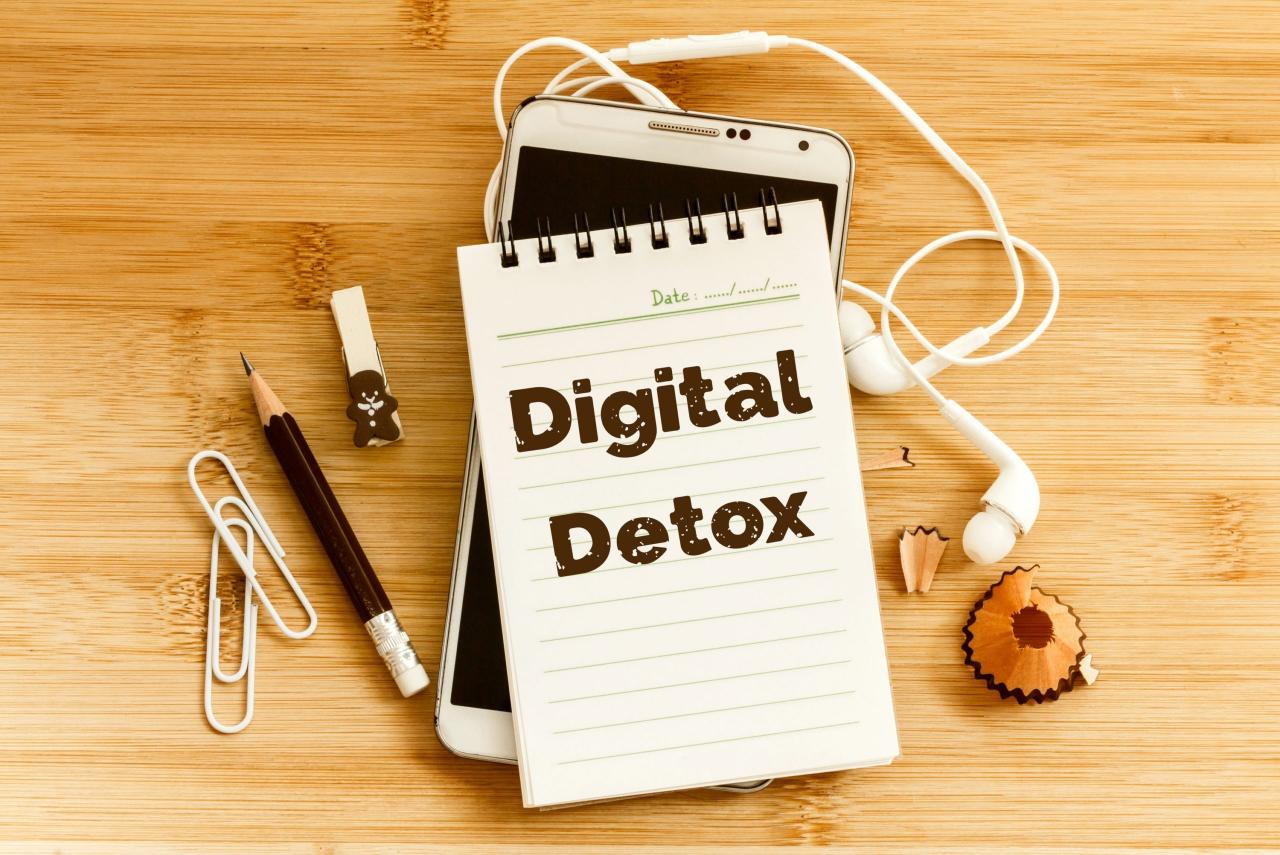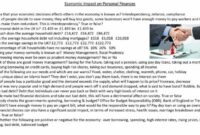Digital detox sets the stage for a journey into reconnecting with yourself and the world around you. This exploration delves into the art of disconnecting from technology to rediscover inner peace and enhance overall well-being. We’ll explore the many facets of digital detox, from its benefits and drawbacks to practical methods and real-world examples. It’s a powerful tool for self-improvement, but it’s important to understand both sides of the coin.
This comprehensive guide provides a deep dive into understanding digital detox, covering everything from its definition and historical context to practical applications and its impact on relationships. We’ll examine how technology can both aid and hinder the process, exploring different methods, strategies, and tools. The key is to learn how to navigate this digital age effectively and thoughtfully.
Defining Digital Detox
A digital detox is a conscious effort to reduce or eliminate exposure to digital devices and technologies for a period of time. It’s a practice gaining popularity as individuals grapple with the increasing demands and pervasive influence of technology in their lives. This intentional disconnection aims to foster a healthier relationship with technology and promote well-being.
This conscious unplugging goes beyond simply putting your phone on silent. It’s about actively choosing to limit or eliminate access to various digital platforms and devices, with the goal of improving focus, reducing stress, and fostering a greater appreciation for non-digital experiences. The core principle is to reclaim control over one’s time and attention from the constant pull of notifications and online interactions.
Different Perspectives on Digital Detox
Digital detox is viewed differently across various aspects of life. For individuals, it’s a personal journey towards self-care and a healthier relationship with technology. Societally, it reflects a growing awareness of the potential downsides of excessive screen time and the need for a balanced lifestyle. From a technological perspective, digital detox highlights the influence of technology on human behavior and the importance of designing tools and interfaces that promote well-being.
Key Characteristics and Goals of Digital Detox
Digital detox is characterized by deliberate limits on access to digital devices and platforms. A core goal is to enhance mental well-being by reducing stress and anxiety often associated with constant connectivity. Improved focus and concentration are also frequently cited benefits. Other goals include increased productivity in non-digital areas, greater appreciation for offline activities, and a strengthened sense of self. Ultimately, the practice is designed to foster a healthier relationship with technology, allowing for a more balanced and fulfilling life.
Historical Context and Evolution of Digital Detox
The concept of digital detox has evolved alongside the rapid proliferation of technology. Early forms of disconnecting from technology, like taking breaks from reading or working with paper, existed long before the internet. However, the modern iteration is directly tied to the rise of smartphones, social media, and the 24/7 availability of digital content. The concept has become increasingly relevant as people experience heightened levels of digital overload.
Types of Digital Detox
A digital detox can take many forms, catering to individual needs and preferences. Short-term detoxes, often lasting a few days or a week, are popular for a quick reset. Longer detoxes, spanning several weeks or even months, aim for a more profound shift in lifestyle and mindset. Specific app detoxes focus on limiting access to particular applications or social media platforms, like social media or gaming. These different types allow individuals to tailor the detox to their specific needs and goals.
- Short-Term Detox: A short-term digital detox, often lasting a few days, can be a useful tool for recharging and regaining focus. This type of detox is particularly beneficial for those who experience frequent digital overload. Examples include weekend getaways where access to digital devices is limited or a week-long vacation with minimal or no digital interaction.
- Long-Term Detox: A long-term detox often entails a significant reduction or complete elimination of digital interaction for a longer period. This approach is typically employed by individuals seeking a more substantial shift in their lifestyle and relationship with technology. Examples include individuals relocating to rural areas to minimize their interaction with digital devices or people choosing to unplug from their jobs during their vacation periods to avoid digital interactions.
- Specific App Detox: A specific app detox involves limiting or removing access to particular apps or platforms. For instance, limiting access to social media or gaming apps can help individuals regain control over their digital habits and reduce distractions. This type of detox can be used to improve focus on tasks or reduce feelings of anxiety.
Benefits and Drawbacks

Source: tickhr.com
Taking a digital detox is becoming increasingly important, especially in today’s fast-paced world. Start-up culture often fosters a culture of non-stop work and constant connectivity , making it even more crucial to disconnect regularly. This can help prevent burnout and allow for a healthier work-life balance, something that’s crucial for long-term success, both personally and professionally.
A digital detox, while appealing to many, isn’t a simple solution. Understanding both the potential upsides and downsides is crucial for anyone considering taking a break from their devices. The effects can vary significantly depending on individual habits, lifestyle, and the duration of the detox.
Taking a break from the constant stimulation of screens can offer some significant benefits, but it’s important to acknowledge the potential downsides as well. This section will explore the advantages and disadvantages of digital detox, looking at how they might differ across various demographics and even impact society as a whole.
Potential Advantages of Digital Detox
A digital detox can lead to significant improvements in well-being, fostering a healthier relationship with technology. Taking time away from screens can help individuals reclaim their time and focus on other activities.
- Improved Mental Well-being: Reduced stress and anxiety are common reported benefits. This is often linked to decreased exposure to social media pressures and the constant barrage of information that can trigger negative emotions.
- Enhanced Focus and Concentration: Time away from distracting notifications and social media can improve attention spans and cognitive function. This is especially true for those who are constantly multitasking or find it difficult to concentrate.
- Improved Sleep Quality: Lower exposure to blue light emitted from screens can lead to better sleep patterns. This is a direct result of the impact on the body’s natural sleep-wake cycle.
- Increased Physical Activity: A break from screen time often results in more time for physical activities like exercise, hobbies, and spending time outdoors.
- Stronger Relationships: More time spent interacting with loved ones in person can lead to deeper and more meaningful connections. Face-to-face interactions are invaluable for relationship building.
Potential Disadvantages of Digital Detox
While a digital detox can be beneficial, it’s important to recognize the potential drawbacks. Not everyone will experience positive changes, and some may struggle with the absence of certain aspects of their daily lives.
- Social Isolation: A complete disconnect from social media and messaging apps can lead to feelings of isolation, especially for those who rely on these platforms for social interaction. This can be a challenge for individuals who use these platforms for support or connection.
- Productivity Loss: For professionals heavily reliant on digital tools for work, a detox might hinder productivity. This is especially true for those who use digital tools for research, communication, and collaboration.
- Information Deficit: Individuals might miss out on important updates, news, or opportunities that are disseminated digitally. This is relevant for people who rely on digital channels for crucial information.
- Increased Anxiety: Some individuals might experience increased anxiety due to the lack of constant connection and information. This is a personal reaction and can be exacerbated for those who rely on digital tools for reassurance.
- Difficulties with Scheduling and Organization: The lack of digital reminders and tools for scheduling can make daily tasks more challenging for some. This is true for individuals with busy schedules or those who use technology for organization.
Demographic Differences in Digital Detox Impacts
The experience of a digital detox can vary significantly based on factors like age, occupation, and social status.
| Demographic | Potential Benefits | Potential Drawbacks |
|---|---|---|
| Young Adults (18-25) | Improved mental health, enhanced focus | Social isolation, reduced access to social support networks |
| Professionals (25-55) | Improved focus, reduced stress | Potential productivity loss, difficulty accessing crucial information |
| Seniors (55+) | Improved sleep, reduced stress | Difficulties with technology, potential for social isolation |
| Individuals with Low Income | Reduced expenses, improved focus | Potential lack of access to important digital services (e.g., job applications, educational resources) |
Societal Impact of Digital Detox
The potential for widespread digital detox practices could have significant societal consequences.
- Economic Impacts: Reduced reliance on digital platforms could lead to economic shifts in industries that rely heavily on technology. This might impact e-commerce, online advertising, and the tech sector.
- Social Changes: A decrease in social media use could lead to different social interactions and community structures. This may impact social movements, political discourse, and social support networks.
- Changes in Communication: A reduced reliance on digital communication could lead to a shift towards more traditional methods. This may affect communication strategies, business models, and social interactions.
Methods and Strategies
Taking a break from the digital world can be a powerful way to reconnect with yourself and the real world. Implementing a digital detox effectively involves carefully planning methods and strategies to overcome potential challenges and ensure success. This section Artikels various approaches to achieve a successful digital detox.
Methods for Implementing a Digital Detox
Different methods can help you disconnect from the digital world. These methods can range from simple adjustments to more drastic measures, tailored to your individual needs and goals.
- Scheduling: A structured approach to limiting digital usage is crucial. Establishing specific times for checking social media, email, or other apps can help you regain control over your digital interactions. This could involve designated “digital-free” hours, days, or even entire periods.
- Uninstallation: Removing apps that are not essential can significantly reduce the temptation to use them. If a particular app or website is a significant source of distraction or problematic usage, uninstallation can be a powerful step. This can be a particularly effective strategy for users who find it difficult to control usage limits.
- Usage Limits: Utilizing built-in phone features or third-party apps can help set time constraints on specific apps. This approach offers a controlled method for managing digital usage. This method can be effective in minimizing the temptation to use distracting apps, especially for users who find themselves spending excessive time on their devices.
Strategies for Managing Challenges During a Digital Detox
Potential challenges during a digital detox may arise from a lack of social interaction or concerns about productivity. Addressing these challenges proactively can help you maintain a successful digital detox.
- Social Interaction: Plan offline activities with friends and family to maintain connections during the detox. Arrange physical gatherings, board game nights, or other activities that do not involve digital devices. This approach helps maintain social connections without relying on digital platforms. Using pre-planned social activities as a buffer for avoiding potential digital temptations can be highly beneficial.
- Productivity: Identify alternative tasks to maintain productivity during the detox. This could involve pursuing hobbies, engaging in physical activity, or focusing on personal projects that do not require constant digital access. This is a crucial aspect of the digital detox, as it addresses the potential feeling of lost productivity and allows you to find productive alternatives in the real world.
A Step-by-Step Guide to Initiating and Maintaining a Successful Digital Detox
This guide Artikels a phased approach to help you implement and maintain a digital detox effectively.
- Assessment: Identify your digital habits and patterns. Track your usage of different apps and websites to understand where your time is being spent. This initial step is vital for recognizing the areas that require the most attention during the detox.
- Planning: Create a personalized plan for your detox. Set realistic goals, establish specific times for limiting digital usage, and identify alternative activities to maintain productivity and social connections. Thorough planning is critical to ensure that your detox plan aligns with your individual needs and goals.
- Implementation: Put your plan into action. Uninstalling non-essential apps, setting usage limits, and scheduling digital-free times are crucial steps in implementing the detox plan. Strict adherence to the plan is necessary for a successful detox.
- Maintenance: Develop strategies to maintain your digital detox habits. This could involve sticking to your schedule, identifying triggers, and seeking support from friends or family. Maintaining a digital detox is a continuous process that requires consistent effort and a long-term commitment.
Examples of Successful Digital Detox Programs or Initiatives
Numerous initiatives and programs have successfully encouraged digital detox practices. Many companies and individuals have implemented strategies for creating digital wellness.
- “Tech Sabbath”: This initiative encourages people to disconnect from technology on a regular basis. This involves a complete disconnect from devices and social media on specific days, typically for 24 hours or more. It promotes mindful and intentional breaks from the digital world.
Technology and Tools
Technology plays a surprisingly significant role in both hindering and helping our digital detox efforts. While constant connectivity and notifications are often the enemy of a peaceful break, the same technology can be leveraged to support and track our progress. Smart tools can provide reminders, monitor usage, and even help us redirect our attention.
Modern apps and devices offer an array of features that can assist in managing our digital habits. These tools can be instrumental in establishing boundaries and achieving a healthier relationship with technology. It’s important to understand how to use these tools effectively and ethically, as technology can be a double-edged sword.
Tools for Facilitating Digital Detox
Digital detox tools can take many forms, from simple reminders to sophisticated apps that track usage and suggest healthier alternatives. These tools can help users become more aware of their digital habits and make informed choices.
- Dedicated Apps and Websites: Many apps are specifically designed to help with digital detox. These often include features like time limits, blocking certain websites, and notification management. Some apps track screen time and offer personalized insights into usage patterns. This data can be valuable in identifying problematic behaviors and creating targeted strategies for improvement. For example, Forest app encourages users to stay focused by planting a virtual tree that dies if they use their phone. This gamified approach can make the process more engaging and enjoyable.
- Built-in Device Settings: Smartphones and computers have built-in features that can be adjusted to limit distractions and encourage more mindful usage. These features can include screen time limits, app usage restrictions, and scheduled downtime. Proper configuration of these settings can be highly effective in reducing excessive screen time and promoting a more balanced approach to technology.
- Social Media Management Tools: Dedicated tools can help control social media usage. Some platforms offer features that allow users to schedule posts or take breaks from specific accounts. This can be useful for managing social media interactions and avoiding excessive scrolling or comparison.
Monitoring and Tracking Digital Detox
Tracking digital detox progress is essential for understanding how effective the strategy is and for identifying areas for improvement. These methods provide valuable insights into the impact of the detox.
- Screen Time Tracking: Many smartphones and operating systems offer built-in tools for tracking screen time. This data can be used to identify specific apps or activities that consume the most time. Knowing this data empowers users to make informed decisions about how to manage their digital interactions.
- Usage Reports and Analytics: Some apps provide detailed usage reports and analytics. These reports can highlight patterns and trends in digital behavior. For example, if someone notices a significant increase in screen time during specific hours of the day, they can implement strategies to address this issue. Analysis of this data helps in identifying areas where users need to adjust their approach.
Examples of Digital Detox Tools
Numerous applications and websites are available to support digital detox practices. They provide different functionalities and approaches.
- Freedom: This app allows users to block specific websites and apps for set periods of time. It helps in creating boundaries and controlling distractions.
- Cold Turkey: This app helps users to quickly remove themselves from distracting apps or websites.
- Offtime: This app helps users set specific timeframes to use their phone or computer, promoting mindful use.
Ethical Considerations of Using Technology for Digital Detox
Using technology to manage technology use raises ethical considerations. These concerns must be addressed to ensure responsible and beneficial outcomes.
- Privacy and Data Security: Digital detox tools may collect user data. It’s essential to be aware of the data privacy policies of these tools and to choose platforms that prioritize user data security.
- Potential for Dependence: Over-reliance on digital tools for managing digital use can create a new form of dependence. A balanced approach that integrates mindful practices with technology is essential to avoid this pitfall.
Practical Applications
Putting digital detox strategies into practice can be incredibly beneficial for various aspects of life. Understanding how to tailor these strategies to specific situations and individuals is key to maximizing their effectiveness. Different people face different challenges when trying to disconnect, and acknowledging these differences allows for more personalized and successful outcomes.
Digital Detox Scenarios
Different life stages and roles present unique challenges when it comes to digital detox. Recognizing these scenarios and the specific hurdles involved is essential for developing effective solutions.
| Scenario | Typical Challenges | Potential Solutions |
|---|---|---|
| Student | Balancing academics with social media, distractions from online games or social platforms, difficulty separating study time from leisure time. | Establishing specific study hours with designated digital-free periods, using website blockers to limit access to distracting sites, creating a dedicated study space free from digital devices. |
| Professional | Staying connected with colleagues and clients, maintaining productivity while disconnected, potential impact on work deliverables, fear of missing out on crucial information or urgent tasks. | Communicating clear expectations about availability, utilizing tools that allow for controlled communication during downtime, prioritizing tasks and using time management techniques, setting boundaries with colleagues and clients about digital availability. |
| Family | Balancing family time with screen use, managing children’s screen time, maintaining family connections while minimizing screen use, creating a shared understanding about digital use. | Establishing family media rules and schedules, designating specific digital-free zones or times within the home, engaging in family activities that don’t involve screens, promoting open communication about digital use and expectations. |
Challenges and Solutions
Addressing specific challenges associated with each scenario is crucial for successful implementation.
| Scenario | Specific Challenges | Potential Solutions |
|---|---|---|
| Student | Feeling overwhelmed by academic demands and the need to constantly check social media, difficulty focusing on studies due to constant notifications and distractions. | Setting dedicated study hours, using website blockers or app timers to limit access to distracting sites, creating a study environment free from digital devices, actively engaging in mindfulness and stress-reducing techniques. |
| Professional | Difficulty disconnecting from work emails and messages, fear of missing important communications or urgent tasks, pressure to be constantly available. | Communicating clear expectations about availability, utilizing tools for controlled communication during downtime, prioritizing tasks and using time management techniques, setting boundaries with colleagues and clients about digital availability. |
| Family | Maintaining healthy family connections while minimizing screen time, managing children’s screen time and online behavior, difficulty creating a shared understanding about digital use. | Establishing family media rules and schedules, creating digital-free zones or times within the home, engaging in family activities that don’t involve screens, promoting open communication about digital use and expectations. |
Actionable Steps
Implementing a digital detox requires a practical approach. Here are some steps to take.
- Identify specific areas where you want to reduce screen time, such as social media, email, or gaming.
- Create a schedule that incorporates designated digital-free periods.
- Establish clear boundaries with family members or colleagues regarding digital availability.
- Utilize technology to help manage screen time, such as app timers or website blockers.
- Engage in activities that don’t involve screens, such as spending time in nature, reading, or exercising.
Realistic Goals
Setting realistic goals is essential for sustained success. It’s crucial to avoid overly ambitious targets that lead to frustration and eventual abandonment of the detox.
“A gradual approach, focusing on small, achievable steps, is more likely to result in long-term behavioral changes.”
Setting realistic goals is a key component of a successful digital detox. It’s essential to avoid setting unrealistic expectations that might lead to failure. Focusing on incremental improvements, rather than drastic changes, often leads to more sustainable outcomes.
Impact on Wellbeing
Digital detox isn’t just about disconnecting from technology; it’s about reconnecting with ourselves and our well-being. The constant barrage of notifications, social media updates, and emails can contribute to stress, anxiety, and a sense of being overwhelmed. A well-planned digital detox can help restore balance and foster a healthier relationship with technology.
Excessive screen time is linked to various negative health outcomes, impacting both mental and physical well-being. The constant stimulation and pressure to engage can lead to sleep disturbances, eye strain, and even physical discomfort. Mental health is also affected by the constant comparison and pressure to present an idealized online persona.
Mental Health and Well-being
Digital detox allows for a significant reduction in stress and anxiety. When we’re not constantly bombarded with information and notifications, our minds can rest and process emotions more effectively. This can lead to improved mood regulation and a greater sense of calm. Studies show a correlation between reduced screen time and decreased symptoms of anxiety and depression. The absence of the constant need to respond or engage online allows for introspection and self-reflection, ultimately fostering a greater sense of self-awareness.
Link Between Excessive Screen Time and Negative Health Outcomes
The constant stimulation of screens can disrupt sleep patterns. The blue light emitted from devices interferes with melatonin production, making it harder to fall asleep and stay asleep. This, in turn, can affect mood, energy levels, and overall cognitive function. Furthermore, the pressure to maintain an online persona can lead to feelings of inadequacy and social comparison. This can significantly impact self-esteem and mental well-being.
Fostering Mindfulness and Presence
Digital detox encourages mindfulness by creating space for present moment awareness. When we disconnect from the digital world, we’re more likely to engage with our surroundings and experiences. This can lead to increased appreciation for the beauty and richness of the present moment. By disconnecting, we can also foster deeper connections with others, focusing on genuine interactions and meaningful conversations rather than superficial online interactions.
Strategies for Incorporating Digital Detox into a Holistic Wellness Routine
Developing a sustainable digital detox routine requires careful planning and self-awareness. Begin with small steps, such as setting specific times for checking social media or limiting phone usage during meals or personal time.
- Establish clear boundaries: Define specific times for checking social media, emails, or other digital platforms. For example, designating a set period in the evening for checking emails before turning off the devices altogether. This helps create a sense of control and structure.
- Embrace offline activities: Engage in activities that don’t involve technology, such as reading a book, spending time in nature, practicing yoga, or engaging in hobbies. These activities promote relaxation, reduce stress, and foster creativity. Examples include pursuing a new skill, taking a walk in the park, or simply enjoying a meal without distractions.
- Prioritize sleep: Consistent sleep patterns are crucial for mental and physical well-being. Establishing a relaxing bedtime routine and avoiding screen time before bed can significantly improve sleep quality. Creating a sleep sanctuary can help, like a dark, quiet room with a comfortable bed.
Digital Detox and Relationships
A digital detox, by its very nature, impacts our interactions with others. It forces us to confront the extent to which our daily lives are interwoven with technology and how that impacts our relationships. This shift in focus can have profound effects, both positive and negative, on our connections with family, friends, and partners.
Effects on Interpersonal Relationships
Digital detox can significantly alter interpersonal dynamics. Constant connectivity often leads to superficial interactions, rushed conversations, and a lack of genuine presence. A period of disconnecting from technology can lead to a deeper, more meaningful connection by encouraging face-to-face interactions and active listening. This can lead to increased empathy and understanding between individuals. Conversely, a sudden shift to less digital interaction can also cause initial discomfort or miscommunication, as individuals adjust to a new mode of relating.
Improving Communication and Connection
A digital detox can foster more meaningful communication. When we’re not constantly checking notifications or responding to messages, we’re more present in conversations. This allows for deeper engagement, active listening, and a more focused exchange of ideas and emotions. We can pay attention to nonverbal cues, observe body language, and truly hear what the other person is saying, leading to improved understanding and stronger bonds.
Managing Conflicts and Misunderstandings
Digital detox can help reduce misunderstandings and conflicts that arise from digital communication. The absence of immediate responses and the ability to reflect on messages before reacting can help prevent impulsive and potentially hurtful interactions. When confronted with a conflict, individuals have the opportunity to approach it with a clearer head and a more considered response, leading to more productive discussions and resolutions. It’s crucial to acknowledge that digital detox doesn’t automatically eliminate all conflicts; it provides a tool for more effective conflict resolution. Open communication and a willingness to understand differing perspectives are still essential.
Impact on Family Dynamics
Family dynamics can be profoundly affected by a digital detox. Families who spend excessive time on screens often find it challenging to connect and share meaningful experiences. A period of reduced screen time allows families to create shared memories and build stronger bonds. Activities like board games, cooking together, or simply spending time outdoors can strengthen relationships and promote a sense of unity. However, it’s important to remember that the adjustment period may require open communication and a willingness to adapt on the part of all family members. For example, establishing new routines and expectations around technology use can help families navigate the transition smoothly.
Illustrative Examples
Digital detox, while beneficial, isn’t a one-size-fits-all solution. Real-world experiences offer valuable insights into successful implementation, challenges encountered, and the transformative power of disconnecting. Understanding these diverse scenarios provides a more comprehensive perspective on the journey towards a healthier digital relationship.
A Successful Digital Detox Scenario
Amelia, a 30-year-old marketing executive, felt overwhelmed by constant notifications and the pressure to be constantly connected. She decided on a 7-day digital detox. For the first few days, she experienced withdrawal symptoms, but her mindfulness practice helped. She filled her time with activities she enjoyed – hiking, painting, and spending quality time with loved ones. By the end of the week, Amelia felt a significant reduction in stress and anxiety. She discovered she could be productive without constantly checking her phone and emails. Crucially, she identified specific triggers and developed healthier coping mechanisms, such as scheduling dedicated time for work-related tasks. This allowed her to maintain a healthy work-life balance.
A Hypothetical Case Study
Mark, a 24-year-old student, was heavily reliant on social media for connection and validation. His digital detox was initially challenging. He felt isolated and struggled to maintain focus on his studies. However, he realized his social media use was impacting his sleep and overall well-being. With support from friends and family, Mark gradually reduced his screen time. He found creative ways to connect with others, such as attending club meetings and participating in group projects. This experience showed that while digital detox is a personal journey, it can be supported by a network of people who understand and empathize. The crucial element was a gradual reduction in screen time, alongside establishing healthier social interaction habits.
Positive Impact on a Person’s Life
Sarah, a 45-year-old teacher, had experienced chronic headaches and difficulty concentrating. She attributed these issues to her constant use of email and social media. After implementing a digital detox, Sarah noticed a marked improvement in her physical and mental health. She spent more time engaging with her hobbies, such as gardening and reading. The reduction in screen time allowed her to focus on her well-being and connect more deeply with her family. This case demonstrates how a digital detox can have a significant, tangible impact on a person’s overall health and quality of life.
Successful Implementation of Digital Detox Strategies
Aisha, a 28-year-old freelance writer, implemented a multi-pronged digital detox approach. She used a dedicated app to track her screen time and scheduled specific times for checking emails and social media. She replaced social media browsing with mindful activities like yoga and meditation. Aisha actively sought out real-life connections and made time for hobbies that didn’t involve screens. She set clear boundaries with her technology, using “Do Not Disturb” modes and limiting notifications. This comprehensive approach enabled Aisha to achieve a significant reduction in stress and improve her focus and productivity. She found that digital detox was not about complete abstinence but about regaining control over her relationship with technology.
Ultimate Conclusion
In conclusion, digital detox isn’t about abandoning technology entirely, but rather about cultivating a healthier relationship with it. By understanding the benefits, drawbacks, and practical strategies, you can create a personalized approach that supports your well-being and fosters a more balanced life. This journey towards a more mindful digital existence empowers you to reclaim control over your time and connect with yourself and others in more meaningful ways. Remember, the goal is a balanced approach to technology that improves your overall quality of life.
Essential Questionnaire
What are some common misconceptions about digital detox?
Many believe digital detox means completely disconnecting from all technology, which isn’t necessary or even desirable. A successful detox often involves strategic disconnection rather than complete abandonment.
How long should a digital detox last?
There’s no one-size-fits-all answer. The duration depends on individual needs and goals. Short-term detoxes can be as short as a weekend, while long-term ones might involve a longer period. Experiment to find what works best for you.
Can digital detox improve my relationships?
Absolutely. By reducing distractions and focusing on real-life interactions, digital detox can foster stronger connections and deeper communication with loved ones. It allows for more meaningful conversations and shared experiences.
What if I feel unproductive during a digital detox?
It’s normal to feel a bit adrift initially. Plan for alternative activities and find ways to stay engaged and productive in other ways, like hobbies or physical exercise. Focus on tasks that don’t require constant technological support.
Taking a break from the digital world, a digital detox, can be really beneficial for mental well-being. However, for some, like those deeply immersed in an online gaming lifestyle, Online gaming lifestyle can be a significant part of their lives, and a detox might feel challenging. Ultimately, the goal of a digital detox is to find a healthy balance between online and offline activities.
Taking a digital detox can be a great way to disconnect and recharge, especially if you live in a city. The constant stimulation and noise can be overwhelming. Sometimes, escaping to a quieter suburban environment, like the ones discussed in Suburban vs. city life , can help you find the peace you need to truly disconnect. Ultimately, a digital detox is about finding a balance between your digital life and the real world, regardless of where you live.
Taking a digital detox can be a great way to disconnect and recharge, especially if you live in a city. The constant stimulation and noise can be overwhelming. Sometimes, escaping to a quieter suburban environment, like the ones discussed in Suburban vs. city life , can help you find the peace you need to truly disconnect. Ultimately, a digital detox is about finding a balance between your digital life and the real world, regardless of where you live.
Taking a digital detox can be a great way to disconnect and recharge, especially if you live in a city. The constant stimulation and noise can be overwhelming. Sometimes, escaping to a quieter suburban environment, like the ones discussed in Suburban vs. city life , can help you find the peace you need to truly disconnect. Ultimately, a digital detox is about finding a balance between your digital life and the real world, regardless of where you live.





